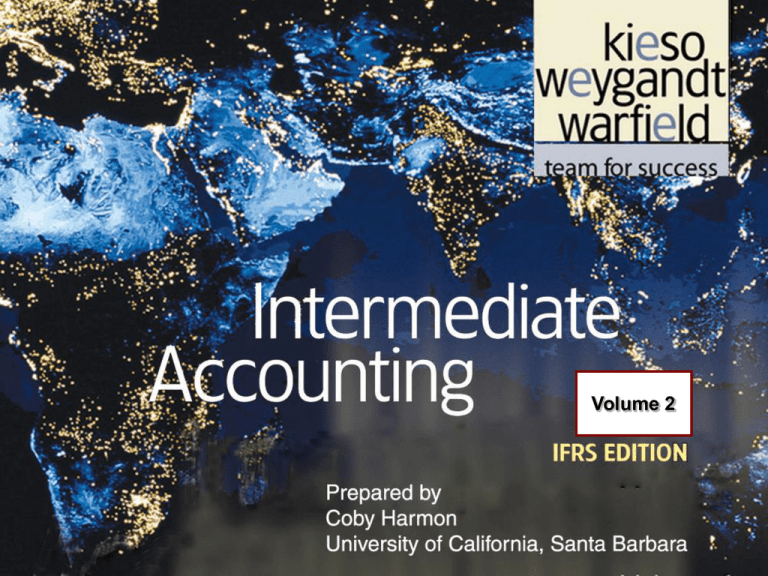
Volume 2
17-1
CHAPTER
17
INVESTMENTS
Intermediate Accounting
IFRS Edition
Kieso, Weygandt, and Warfield
17-2
Learning Objectives
1.
Describe the accounting framework for financial assets.
2.
Understand the accounting for debt investments at amortized cost.
3.
Understand the accounting for debt investments at fair value.
4.
Describe the accounting for the fair value option.
5.
Understand the accounting for equity investments at fair value.
6.
Explain the equity method of accounting and compare it to the fair
value method for equity investments.
7.
Discuss the accounting for impairments of debt investments.
8.
Describe the accounting for transfer of investments between
categories.
17-3
Investments
Debt Investments
Other Reporting
Issues
Amortized cost
Fair value
Impairment of value
Fair value
Equity method
Fair value option
Consolidation
Transfers between
categories
Summary of debt
investment accounting
17-4
Investments in
Equity Securities
Fair value controversy
Summary
Accounting for Financial Assets
Financial Asset
Cash.
Equity investment of another company (e.g., ordinary or
preference shares).
Contractual right to receive cash from another party
(e.g., loans, receivables, and bonds).
IASB requires that companies classify financial assets into two
measurement categories—amortized cost and fair value—
depending on the circumstances.
17-5
LO 1 Describe the accounting framework for financial assets.
Accounting for Financial Assets
Measurement Basis—A Closer Look
IFRS requires that companies measure their financial assets
based on two criteria:
Company’s business model for managing its financial
assets; and
Contractual cash flow characteristics of the financial
asset.
Only debt investments such as receivables, loans, and bond
investments that meet the two criteria above are recorded at amortized
cost. All other debt investments are recorded and reported at fair value.
17-6
LO 1 Describe the accounting framework for financial assets.
Accounting for Financial Assets
Measurement Basis—A Closer Look
Equity investments are generally recorded and reported at
fair value.
Summary of Investment Accounting Approaches
17-7
Illustration 17-1
LO 1 Describe the accounting framework for financial assets.
Debt Investments
Debt investments are characterized by contractual
payments on specified dates of
principal and
interest on the principal amount outstanding.
Companies measure debt investments at
17-8
amortized cost or
fair value.
LO 2 Understand the accounting for debt investments at amortized cost.
Debt Investments—Amortized Cost
Illustration: Robinson Company purchased $100,000 of 8%
bonds of Evermaster Corporation on January 1, 2011, at a
discount, paying $92,278. The bonds mature January 1, 2016
and yield 10%; interest is payable each July 1 and January 1.
Robinson records the investment as follows:
January 1, 2011
Debt Investments
Cash
17-9
92,278
92,278
LO 2 Understand the accounting for debt investments at amortized cost.
Debt Investments—Amortized Cost
Illustration 17-3
Schedule of
Interest
Revenue and
Bond
Discount
Amortization—
Effective-Interest
Method
17-10
LO 2
Debt Investments—Amortized Cost
Illustration: Robinson Company records the receipt of the
first semiannual interest payment on July 1, 2011, as follows:
July 1, 2011
Cash
4,000
Debt Investments
Interest Revenue
17-11
614
4,614
LO 2 Understand the accounting for debt investments at amortized cost.
Debt Investments—Amortized Cost
Illustration: Robinson is on a calendar-year basis, it accrues
interest and amortizes the discount at December 31, 2011, as
follows:
December 31, 2011
Interest Receivable
Debt Investments
Interest Revenue
17-12
4,000
645
4,645
LO 2 Understand the accounting for debt investments at amortized cost.
Debt Investments—Amortized Cost
Reporting Bond Investment at Amortized Cost
Illustration 17-3
17-13
LO 2 Understand the accounting for debt investments at amortized cost.
Debt Investments—Amortized Cost
Illustration: Assume that Robinson Company sells its
investment in Evermaster bonds on November 1, 2013, at
99.75 plus accrued interest. Robinson records this discount
amortization as follows:
November 1, 2013
Debt Investments
Interest Revenue
522
522
$522 x 4/6 = $783
17-14
LO 2 Understand the accounting for debt investments at amortized cost.
Debt Investments—Amortized Cost
Computation of the realized gain on sale.
Illustration 17-4
Cash
Interest Revenue (4/6 x $4,000)
Debt Investments
Gain on Sale of Debt Investments
17-15
102,417
2,667
96,193
3,557
LO 2
Debt Investments—Fair Value
Debt investments at fair value follow the same accounting
entries as debt investments held-for-collection during the
reporting period. That is, they are recorded at amortized
cost.
However, at each reporting date, companies
Adjust the amortized cost to fair value.
Any unrealized holding gain or loss reported as part of
net income (fair value method).
17-16
LO 3 Understand the accounting for debt investments at fair value.
Debt Investments—Fair Value
Debt investments at fair value follow the same accounting
entries as debt investments held-for-collection during the
reporting period. That is, they are recorded at amortized
cost.
However, at each reporting date, companies
Adjust the amortized cost to fair value.
Any unrealized holding gain or loss reported as part of
net income (fair value method).
17-17
LO 3 Understand the accounting for debt investments at fair value.
Debt Investments—Fair Value
Illustration: Robinson Company purchased $100,000 of 8%
bonds of Evermaster Corporation on January 1, 2011, at a
discount, paying $92,278. The bonds mature January 1, 2016
and yield 10%; interest is payable each July 1 and January 1.
The journal entries in 2011 are exactly the same as those for
amortized cost.
17-18
LO 3 Understand the accounting for debt investments at fair value.
Debt Investments—Fair Value
Illustration: Entries are the same as those for amortized cost.
17-19
LO 3
Debt Investments—Fair Value
Illustration: To apply the fair value approach, Robinson
determines that, due to a decrease in interest rates, the fair
value of the debt investment increased to $95,000 at
December 31, 2011.
Illustration 17-5
Securities Fair Value Adjustment
Unrealized Holding Gain or Loss—Income
17-20
1,463
1,463
LO 3 Understand the accounting for debt investments at fair value.
Debt Investments—Fair Value
Financial Statement Presentation
Illustration 17-6
17-21
LO 3 Understand the accounting for debt investments at fair value.
Debt Investments—Fair Value
Illustration: At December 31, 2012, assume that the fair
value of the Evermaster debt investment is $94,000.
Illustration 17-7
Unrealized Holding Gain or Loss—Income
Securities Fair Value Adjustment
17-22
2,388
2,388
LO 3 Understand the accounting for debt investments at fair value.
Debt Investments—Fair Value
Financial Statement Presentation
Illustration 17-8
17-23
LO 3 Understand the accounting for debt investments at fair value.
Debt Investments—Fair Value
Illustration 17-7
Illustration: Assume now that Robinson sells its investment in
Evermaster bonds on November 1, 2013, at 99 ¾ plus accrued
interest. The only difference occurs on December 31, 2013. Since
the bonds are no longer owned by Robinson, the Securities Fair
Value Adjustment account should now be reported at zero.
Robinson makes the following entry to record the elimination of
the valuation account.
Securities Fair Value Adjustment
Unrealized Holding Gain or Loss—Income
17-24
925
925
LO 3 Understand the accounting for debt investments at fair value.
Debt Investments—Fair Value
Income Effects on
Debt Investment
(2011-2013)
Illustration 17-9
17-25
LO 3 Understand the accounting for debt investments at fair value.
Debt Investments—Fair Value
Illustration (Portfolio of Securities): Webb Corporation has
two debt investments accounted for at fair value. The following
illustration identifies the amortized cost, fair value, and the
amount of the unrealized gain or loss.
Illustration 17-10
17-26
LO 3 Understand the accounting for debt investments at fair value.
Debt Investments—Fair Value
Illustration (Portfolio of Securities): Webb makes an
adjusting entry at December 31, 2011 to record the decrease in
value and to record the loss as follows.
Unrealized Holding Gain or Loss—Income
Securities Fair Value Adjustment
17-27
9,537
9,537
LO 3 Understand the accounting for debt investments at fair value.
Debt Investments—Fair Value
Illustration (Sale of Debt Investments): Webb Corporation
sold the Watson bonds (from Illustration 17-10) on July 1, 2012,
for $90,000, at which time it had an amortized cost of $94,214.
Illustration 17-11
Cash
90,000
Loss on Sale of Debt Investments
Debt Investments
17-28
4,214
94,214
LO 3 Understand the accounting for debt investments at fair value.
Debt Investments—Fair Value
Illustration (Sale of Debt Investments): Webb reports this
realized loss in the “Other income and expense” section of the
income statement. Assuming no other purchases and sales of
bonds in 2012, Webb on December 31, 2012, prepares the
information:
Illustration 17-12
17-29
LO 3 Understand the accounting for debt investments at fair value.
Debt Investments—Fair Value
Illustration (Sale of Debt Investments): Webb records the
following at December 31, 2012.
Illustration 17-12
Securities Fair Value Adjustment
Unrealized Holding Gain or Loss—Income
17-30
4,537
4,537
LO 3 Understand the accounting for debt investments at fair value.
Debt Investments—Fair Value
Financial Statement Presentation
Illustration 17-13
17-31
LO 3 Understand the accounting for debt investments at fair value.
Fair Value Option
Companies have the option to report most financial assets at
fair value. This option
is applied on an instrument-by-instrument basis and
is generally available only at the time a company first
purchases the financial asset or incurs a financial liability.
If a company chooses to use the fair value option, it
measures this instrument at fair value until the company no
longer has ownership.
17-32
LO 4 Describe the accounting for the fair value option.
Fair Value Option
Illustration: Hardy Company purchases bonds issued by the
German Central Bank. Hardy plans to hold the debt investment
until it matures in five years. At December 31, 2011, the
amortized cost of this investment is €100,000; its fair value at
December 31, 2011, is €113,000. If Hardy chooses the fair value
option to account for this investment, it makes the following
entry at December 31, 2011.
Debt Investment—German Bonds
Unrealized Holding Gain or Loss—Income
17-33
4,537
4,537
LO 4 Describe the accounting for the fair value option.
Summary of Debt Investment Accounting
Illustration 17-14
17-34
LO 4 Describe the accounting for the fair value option.
Equity Investments
Equity investment represents ownership of ordinary,
preference, or other capital shares.
Cost includes price of the security.
Broker’s commissions and fees are recorded as
expense.
The degree to which one corporation (investor) acquires an
interest in the common stock of another corporation
(investee) generally determines the accounting treatment for
the investment subsequent to acquisition.
17-35
LO 5 Understand the accounting for equity investments at fair value.
Equity Investments
Illustration 17-15
Levels of Influence
Determine Accounting Methods
17-36
LO 5 Understand the accounting for equity investments at fair value.
Equity Investments
Illustration 17-16
Accounting and Reporting for
Equity Investments by Category
17-37
LO 5 Understand the accounting for equity investments at fair value.
Equity Investments at Fair Value
Under IFRS, the presumption is that equity investments
are held-for-trading.
General accounting and reporting rule:
17-38
Investments valued at fair value.
Record unrealized gains and losses in net income.
LO 5 Understand the accounting for equity investments at fair value.
Equity Investments at Fair Value
IFRS allows companies to classify some equity
investments as non-trading.
General accounting and reporting rule:
17-39
Investments valued at fair value.
Record unrealized gains and losses in other
comprehensive income.
LO 5 Understand the accounting for equity investments at fair value.
Equity Investments at Fair Value
Illustration: November 3, 2011, Republic Corporation
purchased ordinary shares of three companies, each
investment representing less than a 20 percent interest.
Republic records these investments as follows:
17-40
LO 5 Understand the accounting for equity investments at fair value.
Equity
Investments
at Fair Value
Republic records these investments as follows:
Equity Investments
718,550
Cash
718,550
On December 6, 2011, Republic receives a cash dividend of
€4,200 on its investment in the ordinary shares of Nestlé.
Cash
4,200
Dividend Revenue
17-41
4,200
LO 5 Understand the accounting for equity investments at fair value.
Equity Investments at Fair Value
At December 31, 2011, Republic’s equity investment portfolio has
the carrying value and fair value shown.
Illustration 17-17
17-42
LO 5 Understand the accounting for equity investments at fair value.
Equity Investments at Fair Value
Illustration 17-17
Unrealized Holding Gain or Loss—Income
Securities Fair Value Adjustment
17-43
35,550
35,550
LO 5 Understand the accounting for equity investments at fair value.
Equity Investments at Fair Value
On January 23, 2012, Republic sold all of its Burberry ordinary
shares, receiving €287,220.
Cash
287,220
Equity Investments
Gain on Sale of Equity Investment
17-44
259,700
27,520
LO 5 Understand the accounting for equity investments at fair value.
Equity Investments at Fair Value
In addition, assume that on February 10, 2012, Republic purchased
€255,000 of Continental Trucking ordinary shares (20,000 shares
€12.75 per share), plus brokerage commissions of €1,850.
Republic’s equity investment portfolio as of December 31, 2012.
Illustration 17-19
17-45
LO 5 Understand the accounting for equity investments at fair value.
Equity Investments at Fair Value
Illustration 17-19
Securities Fair Value Adjustment
101,650
Unrealized Holding Gain or Loss—Income
17-46
101,650
LO 5 Understand the accounting for equity investments at fair value.
Equity Investments at Fair Value
Example: Equity Investments (OCI)
The accounting entries to record non-trading equity
investments are the same as for trading equity investments,
except for recording the unrealized holding gain or loss.
Report the unrealized holding gain or loss as other
comprehensive income.
17-47
LO 5 Understand the accounting for equity investments at fair value.
Equity Investments at Fair Value
Illustration: On December 10, 2011, Republic Corporation
purchased 1,000 ordinary shares of Hawthorne Company for
€20.75 per share (total cost €20,750). The investment represents
less than a 20 percent interest. Hawthorne is a distributor for
Republic products in certain locales, the laws of which require a
minimum level of share ownership of a company in that region.
The investment in Hawthorne meets this regulatory requirement.
Republic accounts for this investment at fair value.
Equity Investments
Cash
17-48
20,750
20,750
LO 5 Understand the accounting for equity investments at fair value.
Equity Investments at Fair Value
Illustration: On December 27, 2011, Republic receives a cash
dividend of €450 on its investment in the ordinary shares of
Hawthorne Company. It records the cash dividend as follows.
Cash
Dividend Revenue
17-49
450
450
LO 5 Understand the accounting for equity investments at fair value.
Equity Investments at Fair Value
Illustration: At December 31, 2011, Republic’s investment in
Hawthorne has the carrying value and fair value shown
Illustration 17-21
Securities Fair Value Adjustment
Unrealized Holding Gain or Loss—Equity
17-50
3,250
3,250
LO 5 Understand the accounting for equity investments at fair value.
Equity Investments at Fair Value
Illustration 17-21
Financial Statement Presentation
Securities Fair Value Adjustment
Unrealized Holding Gain or Loss—Equity
17-51
3,250
3,250
LO 5 Understand the accounting for equity investments at fair value.
Equity Investments at Fair Value
Illustration: On December 20, 2012, Republic sold all of its
Hawthorne Company ordinary shares receiving net proceeds of
€22,500.
Illustration 17-22
Cash
22,500
Equity Investments
20,750
Gain on Sale of Equity Investment
Unrealized Holding Gain or Loss—Equity
Securities Fair Value Adjustment
17-52
1,750
3,250
3,250
LO 5
Equity Method
An investment (direct or indirect) of 20 percent or more of the
voting shares of an investee should lead to a presumption that
in the absence of evidence to the contrary, an investor has the
ability to exercise significant influence over an investee.
In instances of “significant influence,” the investor must
account for the investment using the equity method.
17-53
LO 6 Explain the equity method of accounting and compare
it to the fair value method for equity investments.
Equity Method
Equity Method
Record the investment at cost and subsequently adjust
the amount each period for
the investor’s proportionate share of the earnings
(losses) and
dividends received by the investor.
If investor’s share of investee’s losses exceeds the carrying amount of
the investment, the investor ordinarily should discontinue applying the
equity method.
17-54
LO 6 Explain the equity method of accounting and compare
it to the fair value method for equity investments.
Equity Method
Illustration 17-23
17-55
LO 6
Consolidation
Controlling Interest - When one corporation acquires a voting
interest of more than 50 percent in another corporation
Investor is referred to as the parent.
Investee is referred to as the subsidiary.
Investment in the subsidiary is reported on the parent’s
books as a long-term investment.
Parent generally prepares consolidated financial
statements.
17-56
Impairment of Value
Impairment of Value
For debt investments, a company uses the impairment test to
determine whether “it is probable that the investor will be unable
to collect all amounts due according to the contractual terms.”
This impairment loss is calculated as the difference between the
carrying amount plus accrued interest and the expected future
cash flows discounted at the investment’s historical effectiveinterest rate.
17-57
LO 7 Discuss the accounting for impairments of debt investments.
Impairment of Value
Illustration: At December 31, 2010, Mayhew Company has a
debt investment in Bellovary Inc., purchased at par for $200,000.
The investment has a term of four years, with annual interest
payments at 10 percent, paid at the end of each year (the
historical effective-interest rate is 10 percent). This debt
investment is classified as held-for-collection. Using the following
information record the loss on impairment.
17-58
LO 7 Discuss the accounting for impairments of debt investments.
Impairment of Value
Illustration 17-24 & 25
Loss on Impairment
Debt Investments
17-59
12,688
12,688
LO 7
Transfers Between Categories
Transferring an investment from one classification to another
Should occur only when the business model for managing
the investment changes.
IASB expects such changes to be rare.
Companies account for transfers between classifications
prospectively, at the beginning of the accounting period
after the change in the business model.
17-60
LO 8 Describe the accounting for transfer of investments between categories.
Transfers Between Categories
Illustration: British Sky Broadcasting Group plc (GBR) has a
portfolio of debt investments that are classified as trading; that is,
the debt investments are not held-for-collection but managed to
profit from interest rate changes. As a result, it accounts for these
investments at fair value. At December 31, 2010, British Sky has
the following balances related to these securities.
17-61
LO 8 Describe the accounting for transfer of investments between categories.
Transfers Between Categories
Illustration: As part of its strategic planning process, completed
in the fourth quarter of 2010, British Sky management decides to
move from its prior strategy—which requires active
management—to a held-for-collection strategy for these debt
investments. British Sky makes the following entry to transfer
these securities to the held-for-collection classification.
Debt Investments
Securities Fair Value Adjustment
17-62
125,000
125,000
LO 8 Describe the accounting for transfer of investments between categories.
Fair Value Controversy
17-63
Measurement Based on Business Model
Gains Trading
Liabilities Not Fairly Valued
Fair Values—Final Comment
LO 8 Describe the accounting for transfer of investments between categories.
Reporting Treatment of Investments
Illustration 17-26
17-64
LO 8 Describe the accounting for transfer of investments between categories.
17-65
U.S. GAAP classifies investments as trading, available for-sale (both
debt and equity investments), and held to-maturity (only for debt
investments). IFRS uses held-for-collection (debt investments), trading
(both debt and equity investments), and non-trading equity investment
classifications.
The accounting for trading investments is the same between U.S.
GAAP and IFRS. Held-to-maturity (U.S. GAAP) and held-for-collection
investments are accounted for at amortized cost. Gains and losses
related to available-for-sale securities (U.S. GAAP) and non-trading
equity investments (IFRS) are reported in other comprehensive income.
17-66
Both U.S. GAAP and IFRS use the same test to determine whether the
equity method of accounting should be used—that is, significant
influence with a general guide of over 20 percent ownership.
The basis for consolidation under IFRS is control. Under U.S. GAAP, a
bipolar approach is used, which is a risk-and-reward model (often
referred to as a variable-entity approach) and a voting-interest
approach. However, under both systems, for consolidation to occur, the
investor company must generally own 50 percent of another company.
17-67
U.S. GAAP and IFRS are similar in the accounting for the fair value
option. That is, the option to use the fair value method must be made at
initial recognition, the selection is irrevocable, and gains and losses are
reported as part of income. One difference is that U.S. GAAP permits
the fair value option for equity method investments.
While measurement of impairments is similar, U.S. GAAP does not
permit the reversal of an impairment charge related to available-for-sale
debt and equity investments. IFRS allows reversals of impairments of
held-for-collection investments.
Copyright
Copyright © 2011 John Wiley & Sons, Inc. All rights reserved.
Reproduction or translation of this work beyond that permitted in
Section 117 of the 1976 United States Copyright Act without the
express written permission of the copyright owner is unlawful.
Request for further information should be addressed to the
Permissions Department, John Wiley & Sons, Inc. The purchaser
may make back-up copies for his/her own use only and not for
distribution or resale. The Publisher assumes no responsibility for
errors, omissions, or damages, caused by the use of these
programs or from the use of the information contained herein.
17-68









